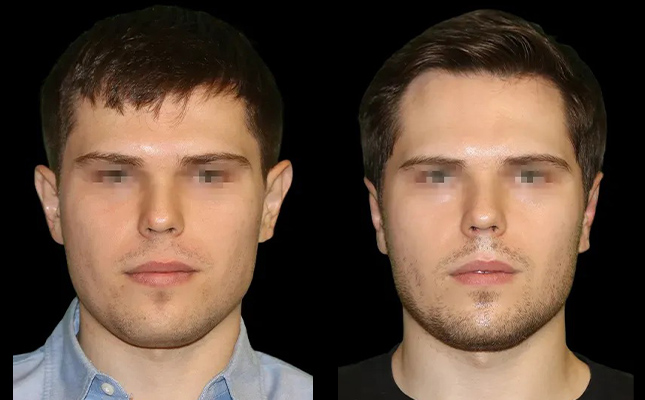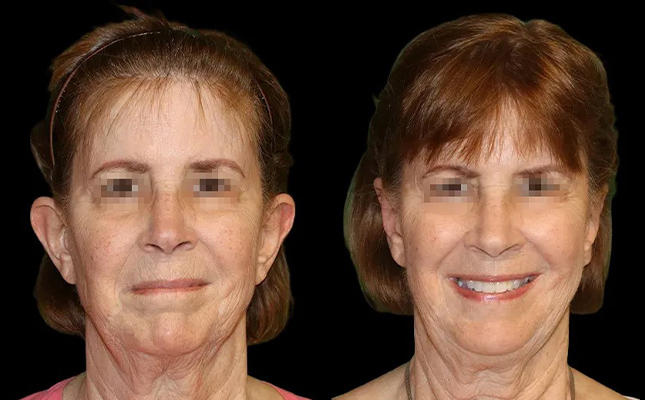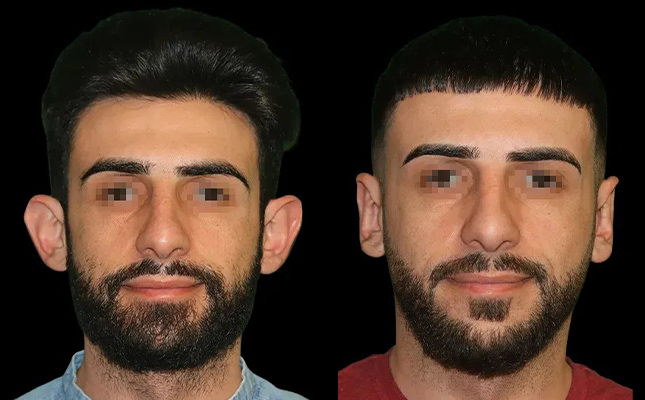Achieve balanced and natural-looking ears with ear surgery (otoplasty). This procedure corrects prominent, misshapen, or asymmetrical ears, restoring harmony to facial features. Dr. Sahar Nadimi offers precise, minimally invasive techniques, often performed in-office under local anesthesia, ensuring a comfortable experience for children and adults alike.
Improve the shape and size of your ears
Otoplasty, commonly known as ear surgery, is a cosmetic procedure that improves the shape, position, or size of the ears. It’s ideal for individuals with prominent, asymmetrical, or misshapen ears due to genetics or injury. The surgery involves reshaping the ear cartilage to create a more natural, proportional appearance that complements facial features. Dr. Nadimi specializes in achieving subtle, natural-looking results tailored to each patient’s anatomy.

Ear surgery (otoplasty) treats:
- Protruding or overly prominent ears
- Asymmetrical ear shape or size
- Ears misshapen due to genetics or injury
- Large or stretched earlobes
- Folded, cupped, or underdeveloped ears (constricted ear deformity)
- Scarring or deformities from prior surgeries or trauma
Ear surgery (otoplasty) Procedure with Dr. Sahar Nadimi
During ear surgery, Dr. Nadimi assesses the structure of the ear and identifies specific areas for improvement. The procedure typically begins with a precise incision along the natural crease behind the ear. Through this incision, excess cartilage may be removed, reshaped, or scored to create a smoother contour.
For ears that protrude excessively, permanent sutures are placed to reposition the cartilage closer to the head, reducing projection. The surgery is performed under local anesthesia in an outpatient setting.

Other types of ear surgery
Ear lobe reductions
Ear lobe reduction surgery addresses elongated or disproportionately large ear lobes, often caused by genetics, aging, or stretching from heavy earrings. The procedure involves removing excess skin and soft tissue to reshape and resize the ear lobe. Dr. Nadimi tailors the incision to the specific area of concern. For example, a wedge excision may be used to remove a portion of the ear lobe, or a circular incision may reshape the entire lobe.
Ear lobe repairs
Ear lobe repair surgery corrects damage from trauma, stretched piercings, or torn ear lobes. Dr. Nadimi begins by debriding the damaged tissue to create clean edges. Depending on the nature of the tear or defect, the ear lobe is repaired using fine sutures to reapproximate the tissue. For stretched lobes caused by gauges, excess skin is removed, and the ear lobe is reshaped to restore a natural appearance. The procedure is performed under local anesthesia.
Benefits of ear surgery (otoplasty):
- Improves ear symmetry and balance with facial features
- Corrects prominent or protruding ears for a more natural contour
- Repairs deformities caused by injury, genetics, or prior surgery
- Reduces the size of overly large or elongated ear lobes
- Provides permanent results with minimal scarring
- Performed under local anesthesia for a safer, more comfortable experience
- Quick recovery time, with most patients resuming normal activities within a week
- Suitable for both children and adults seeking functional or cosmetic improvements


Ear surgery (otoplasty) FAQs
What Age is Appropriate for Ear Surgery?
Ear surgery can be performed on both children and adults. For children, the ideal age is typically around 5 or 6 years old, once the ears have reached about 90% of their adult size. At this age, the cartilage is still malleable, making it easier to reshape. For adults, otoplasty can be performed at any age, as long as you are in good overall health.
How Long Does Ear Surgery Take?
Otoplasty typically takes 1 to 2 hours, depending on the complexity of the procedure. Dr. Nadimi carefully reshapes the ear cartilage and adjusts its position to achieve natural, symmetrical results. If additional procedures, such as ear lobe repair or reduction, are performed simultaneously, the duration may be slightly longer.
Will I Have Visible Scars After Otoplasty?
Scarring from ear surgery is minimal and strategically placed. Dr. Nadimi makes incisions behind the ear, within the natural crease, where they are well-hidden. For ear lobe procedures, scars are small and often fade significantly over time. She also provides post-surgical care recommendations to optimize healing and minimize the visibility of scars.
Can Ear Surgery Correct Asymmetrical Ears?
Yes, otoplasty is highly effective in addressing ear asymmetry. Dr. Nadimi customizes the procedure to reshape and reposition each ear as needed, creating a more balanced and harmonious appearance. Whether the asymmetry is due to genetics, trauma, or prior surgery, she uses advanced techniques to achieve the most natural-looking results possible.
Is Ear Surgery Painful?
Ear surgery is generally well-tolerated, with most patients experiencing only mild discomfort. Local anesthesia ensures you remain comfortable during the procedure. After surgery, you may feel some tightness or soreness, which is manageable with over-the-counter pain medication. Dr. Nadimi will provide detailed aftercare instructions to help minimize any discomfort.
What is the Recovery Process Like?
Recovery after otoplasty is simple. For the first few days, you must wear a soft compression band around your head to protect the ears and support their new position. Swelling and mild bruising usually resolve within 1 to 2 weeks. Most patients return to work, school, or regular activities within a week, though strenuous activities should be avoided for 4 to 6 weeks.
Can Otoplasty Improve Hearing?
Otoplasty is a cosmetic procedure and does not directly improve hearing. However, for individuals with physical deformities or ear canal blockages caused by trauma or congenital conditions, surgery may indirectly enhance hearing by correcting structural issues.
How Soon Will I See the Results After Ear Surgery?
The results from otoplasty are visible immediately after the procedure, though there will be some swelling initially. As the swelling subsides over the following weeks, the final shape and position of the ears become more apparent. Most patients see their complete results within 3 months.

Meet Dr. Nadimi
Dr. Sahar Nadimi is a double board-certified facial plastic surgeon known for her meticulous approach and natural-looking results. As clinical faculty at Loyola University Medical Center, she teaches advanced facial rejuvenation techniques, including otoplasty, to the next generation of plastic surgeons. Dr. Nadimi is committed to delivering personalized care and transformative outcomes, ensuring every patient feels confident and well-cared for. If you’re considering ear surgery, schedule a consultation to explore your options.






